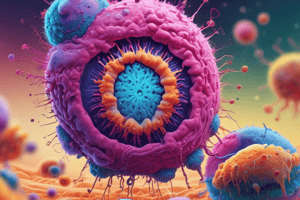Podcast
Questions and Answers
What role does the adherence of pathogenic bacteria play in microbial infections?
What role does the adherence of pathogenic bacteria play in microbial infections?
- It reduces the effectiveness of the immune response.
- It helps bacteria to be flushed out of the body.
- It leads to the development of antibodies.
- It allows bacteria to colonize and cause disease. (correct)
Why are biofilms formed by pathogenic bacteria difficult to treat?
Why are biofilms formed by pathogenic bacteria difficult to treat?
- They are resistant to antibiotic treatments. (correct)
- They form on natural surfaces only.
- They prevent bacteria from adhering to surfaces.
- They increase the body's immune response.
What surgical procedure is often required to successfully treat prosthetic joint infections (PJIs)?
What surgical procedure is often required to successfully treat prosthetic joint infections (PJIs)?
- Antibiotic therapy alone.
- Replacement of the entire prosthesis.
- Amputation of the affected limb.
- Debridement of colonized biofilm. (correct)
Which natural surfaces exhibit antibacterial properties that researchers are studying for biomimetic applications?
Which natural surfaces exhibit antibacterial properties that researchers are studying for biomimetic applications?
What is the primary reason for researchers to explore using titanium dioxide (TiO2) in antibacterial nanofabrication?
What is the primary reason for researchers to explore using titanium dioxide (TiO2) in antibacterial nanofabrication?
What is the key challenge with treating infections associated with implanted medical devices?
What is the key challenge with treating infections associated with implanted medical devices?
What characteristic of shark skin, insect wings, and lotus leaves allows them to kill bacteria on contact?
What characteristic of shark skin, insect wings, and lotus leaves allows them to kill bacteria on contact?
What is a significant threat in orthopedic medicine related to pathogenic bacteria?
What is a significant threat in orthopedic medicine related to pathogenic bacteria?
What is a primary reason TiO2 is promising for medical applications against bacteria?
What is a primary reason TiO2 is promising for medical applications against bacteria?
Why is the portal of entry important for the establishment of an infection?
Why is the portal of entry important for the establishment of an infection?
What role do receptor molecules play in the infection process?
What role do receptor molecules play in the infection process?
Which type of bacteria has shown limited potential for destruction by TiO2?
Which type of bacteria has shown limited potential for destruction by TiO2?
What specific characteristic of the bacterium Streptococcus pneumoniae affects its potential to cause infection?
What specific characteristic of the bacterium Streptococcus pneumoniae affects its potential to cause infection?
What adaptive feature do receptors on pathogens possess?
What adaptive feature do receptors on pathogens possess?
Why would the application of antibacterial nanostructures on medical implants be beneficial?
Why would the application of antibacterial nanostructures on medical implants be beneficial?
What composition primarily makes up adhesins on pathogen surfaces?
What composition primarily makes up adhesins on pathogen surfaces?
Flashcards are hidden until you start studying
Study Notes
Microbial Infection and Pathogenesis
- Pathogenic bacteria adhere to surfaces, including natural tissue surfaces (tooth enamel, mucous membranes) and artificial surfaces (implanted medical devices, catheters, prosthetic heart valves, artificial joints), which leads to the formation of biofilms and disease.
- Biofilms are difficult to treat with antibiotics, and successful treatment often requires physical removal of the colonized biofilm through debridement.
Killing Pathogens on Contact
- Certain animal and plant tissue surfaces (shark skin, insect wings, lotus leaves) exhibit antibacterial properties, killing bacteria on contact by disrupting their cytoplasmic membranes.
- Antibacterial nanofabrication methods have been developed using titanium dioxide (TiO2) to mimic natural contact killing, showing promise in destroying gram-negative bacteria on contact.
Human–Pathogen Interactions
- The portal of entry is critical for the establishment of an infection, as a pathogen that gains access to incompatible tissues is typically ineffective.
- Receptor molecules on the surfaces of both the pathogen and host cells are important for adhering the pathogen to host tissues.
- Specific receptors can be important for the binding of various types of pathogenic microbes (bacteria, viruses, parasites) to host cells.
- Adhesins, composed of glycoprotein or lipoprotein, are receptors on the pathogen surface that bind specifically to complementary molecules in the host, alerting the pathogen that it has arrived on a suitable infection site.
Studying That Suits You
Use AI to generate personalized quizzes and flashcards to suit your learning preferences.




